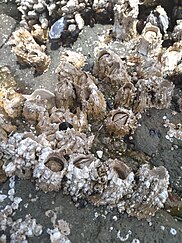
A sexual system is a distribution of male and female function across organisms in a species.[1][2] The terms reproductive system and mating system have also been used as synonyms.[3]
Sexual systems are a key factor for genetic variation and reproductive success, and may also have led to the origin or extinction of certain species.[4] The distinctions between different sexual systems is not always clear due to phenotypic plasticity.[2]
Interests in sexual systems go back to Darwin, who found that barnacles contain species that are androdioecious and some that are dioecious.[5]
- ^ Encyclopedia of Animal Behavior. Vol. 4. Academic Press. 2019-01-21. p. 584. ISBN 978-0-12-813252-4.
- ^ a b Leonard JL (2019-05-21). Transitions Between Sexual Systems: Understanding the Mechanisms of, and Pathways Between, Dioecy, Hermaphroditism and Other Sexual Systems. Springer. p. 1. ISBN 978-3-319-94139-4.
- ^ Cardoso, João Custódio Fernandes; Viana, Matheus Lacerda; Matias, Raphael; Furtado, Marco Túlio; Caetano, Ana Paula de Souza; Consolaro, Hélder; Brito, Vinícius Lourenço Garcia de (Jul–Sep 2018). "Towards a unified terminology for angiosperm reproductive systems". Acta Botanica Brasilica. 32 (3): 329–348. doi:10.1590/0102-33062018abb0124. ISSN 0102-3306. S2CID 91470660.
- ^ Goldberg EE, Otto SP, Vamosi JC, Mayrose I, Sabath N, Ming R, Ashman TL (April 2017). "Macroevolutionary synthesis of flowering plant sexual systems". Evolution; International Journal of Organic Evolution. 71 (4): 898–912. doi:10.1111/evo.13181. PMID 28085192. S2CID 19562183.
- ^ Yusa Y, Yoshikawa M, Kitaura J, Kawane M, Ozaki Y, Yamato S, Høeg JT (March 2012). "Adaptive evolution of sexual systems in pedunculate barnacles". Proceedings. Biological Sciences. 279 (1730): 959–66. doi:10.1098/rspb.2011.1554. PMC 3259936. PMID 21881138.
© MMXXIII Rich X Search. We shall prevail. All rights reserved. Rich X Search
